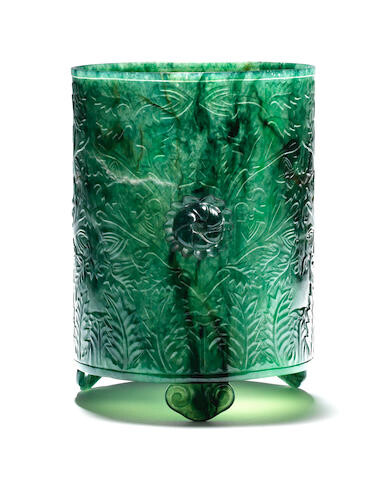A MUGHAL-STYLE SPINACH-GREEN JADE BRUSHPOT, BITONG
Probably Republic Period
Probably Republic Period
The vessel of cylindrical shape standing on three ruyi feet, finely carved with vertical panels depicting intricate designs of large blossoming flowers borne on an undulating foliate meander, all between bands of curling leaves and petals, the stone of deep translucent emerald tone. 17.2cm (6 7/8in) high.
或民國 痕都斯坦式碧玉花葉紋筆筒
Provenance: Sotheby's Paris, 9 June 2010, lot 178
An important European private collection
來源:巴黎蘇富比,2010年6月9日,拍品編號178
歐洲重要私人收藏
The present lot with its crisp floral carving and translucent stone displays distinct influence of Mughal jade-carving styles on Chinese jades. This was due to the favour shown by the Qianlong emperor to Indian (which he termed 'Hindustan') jades. Mughal jade vessels produced in India were renowned for their exceptional carving and naturalistic designs. These objects were traded and gifted as tributes to China via Yarkand, in Central Asia. The Qianlong emperor greatly admired the fine quality of Mughal jade workmanship, and wrote poems praising Mughal pieces in his collection, describing them as 'thin as paper'. Chinese carvers thereafter strove to imitate the Mughal style, combining Chinese decorative elements and symbolism such as the chrysanthemums decorating the handles.
The foreign influence on the present vessel is identifiable by being so thinly carved, thin and translucent enough to allow the light to shine through the walls; and by the frequent use of petal and floral designs. Such 'Hindustan' jade carvings, both the examples from the Mughal empire and the versions carved in China, were highly treasured, as exemplified by the number and variety of examples in the Imperial collections in the National Palace Museum, Taipei and in the Palace Museum, Beijing.
The design of acanthus leaves seen on the present brushpot derives from classical European architecture, and was introduced into the Mughal jade-carving repertoire during the 17th century. Chrysanthemums on the other hand, symbolic of longevity and fertility, have long been closely associated in China with Autumn and the hermetic poet Tao Qian (365-427 AD). Living during a turbulent period in China, he retired in midlife to a small estate to live out his days in rustic obscurity, drinking wine and writing poetry. Private and quiet as his life was, his reputation grew steadily after his death, particularly for his association with chrysanthemums, which he grew in a small patch by the eastern fence of his retirement estate. Since then, chrysanthemums have come to symbolise the literatus ideal of tranquil solitude in one's Autumn years.
Compare the designs of chrysanthemums and plants extending up from the base in low relief as seen on the present brushpot with the low-relief designs decorating a small jade lidded pot, Qing dynasty, illustrated in the National Palace Museum, Exquisite Beauty - Islamic Jades, Taipei, 2007, p.212, no.262.
痕都斯坦即指蒙兀兒帝國,其疆域包括今印度北部、巴基斯坦及阿富汗東部等地,經乾隆皇帝親自考證發音,定名「痕都斯坦」。在蒙兀兒帝國治下,伊斯蘭玉器逐漸形成獨特的裝飾風格,並於十八世紀後期經新疆源源不斷貢入清廷,令乾隆皇帝大為激賞。乾隆皇帝認為薄、透、輕巧,是痕都斯坦玉工的絕技,多次賦詩盛讚這種雕刻精細、紋飾繁複的裝飾工藝,內務府亦設立專門仿製痕玉的作坊。中國工匠由此大量吸收痕玉工藝特點,結合中國傳統器形和裝飾主題,創造出帶有西番風格的玉器,本品即為絕佳例證。
此類風格的一大特點是胎體輕薄、透明,由外透過器壁能看到器內盛裝的物體,由內透過器壁又能看到外壁上浮雕的花紋。台北國立故宮博物院和北京故宮博物院館藏清宮舊藏各式大量痕都斯坦式玉器,彼時流行程度可見一斑。
花葉紋是痕都斯坦式玉器的主流紋飾。本例主體浮雕莨苕紋,源自歐洲古典建築的邊緣卷葉紋飾,十七世紀左右引入伊斯蘭玉雕工藝。工匠常於一件玉器的器心或外壁等部位,選擇不同的花種,配上長長短短的淺浮雕莨苕紋,使器物整體豐美優雅又富韻律感。而菊花紋飾則意味長壽有徵、多子多福;又因其耐霜雪之特性而被賦予人格化的精神。晉陶淵明不為五斗米而折腰,辭官歸田,淡泊明志;其「採菊東籬下,悠然見南山」的逍遙適意,從此賦予了菊花堅韌而不流俗的文人氣節。
參考台北國立故宮博物院藏一例清痕都斯坦式玉雕蓋罐,同樣以菊花及浮雕葉紋為飾,見鄧淑蘋著,《國色天香:伊斯蘭玉器》,台北,2007年,頁212,編號262。
View it on
Estimate
Time, Location
Auction House
Probably Republic Period
Probably Republic Period
The vessel of cylindrical shape standing on three ruyi feet, finely carved with vertical panels depicting intricate designs of large blossoming flowers borne on an undulating foliate meander, all between bands of curling leaves and petals, the stone of deep translucent emerald tone. 17.2cm (6 7/8in) high.
或民國 痕都斯坦式碧玉花葉紋筆筒
Provenance: Sotheby's Paris, 9 June 2010, lot 178
An important European private collection
來源:巴黎蘇富比,2010年6月9日,拍品編號178
歐洲重要私人收藏
The present lot with its crisp floral carving and translucent stone displays distinct influence of Mughal jade-carving styles on Chinese jades. This was due to the favour shown by the Qianlong emperor to Indian (which he termed 'Hindustan') jades. Mughal jade vessels produced in India were renowned for their exceptional carving and naturalistic designs. These objects were traded and gifted as tributes to China via Yarkand, in Central Asia. The Qianlong emperor greatly admired the fine quality of Mughal jade workmanship, and wrote poems praising Mughal pieces in his collection, describing them as 'thin as paper'. Chinese carvers thereafter strove to imitate the Mughal style, combining Chinese decorative elements and symbolism such as the chrysanthemums decorating the handles.
The foreign influence on the present vessel is identifiable by being so thinly carved, thin and translucent enough to allow the light to shine through the walls; and by the frequent use of petal and floral designs. Such 'Hindustan' jade carvings, both the examples from the Mughal empire and the versions carved in China, were highly treasured, as exemplified by the number and variety of examples in the Imperial collections in the National Palace Museum, Taipei and in the Palace Museum, Beijing.
The design of acanthus leaves seen on the present brushpot derives from classical European architecture, and was introduced into the Mughal jade-carving repertoire during the 17th century. Chrysanthemums on the other hand, symbolic of longevity and fertility, have long been closely associated in China with Autumn and the hermetic poet Tao Qian (365-427 AD). Living during a turbulent period in China, he retired in midlife to a small estate to live out his days in rustic obscurity, drinking wine and writing poetry. Private and quiet as his life was, his reputation grew steadily after his death, particularly for his association with chrysanthemums, which he grew in a small patch by the eastern fence of his retirement estate. Since then, chrysanthemums have come to symbolise the literatus ideal of tranquil solitude in one's Autumn years.
Compare the designs of chrysanthemums and plants extending up from the base in low relief as seen on the present brushpot with the low-relief designs decorating a small jade lidded pot, Qing dynasty, illustrated in the National Palace Museum, Exquisite Beauty - Islamic Jades, Taipei, 2007, p.212, no.262.
痕都斯坦即指蒙兀兒帝國,其疆域包括今印度北部、巴基斯坦及阿富汗東部等地,經乾隆皇帝親自考證發音,定名「痕都斯坦」。在蒙兀兒帝國治下,伊斯蘭玉器逐漸形成獨特的裝飾風格,並於十八世紀後期經新疆源源不斷貢入清廷,令乾隆皇帝大為激賞。乾隆皇帝認為薄、透、輕巧,是痕都斯坦玉工的絕技,多次賦詩盛讚這種雕刻精細、紋飾繁複的裝飾工藝,內務府亦設立專門仿製痕玉的作坊。中國工匠由此大量吸收痕玉工藝特點,結合中國傳統器形和裝飾主題,創造出帶有西番風格的玉器,本品即為絕佳例證。
此類風格的一大特點是胎體輕薄、透明,由外透過器壁能看到器內盛裝的物體,由內透過器壁又能看到外壁上浮雕的花紋。台北國立故宮博物院和北京故宮博物院館藏清宮舊藏各式大量痕都斯坦式玉器,彼時流行程度可見一斑。
花葉紋是痕都斯坦式玉器的主流紋飾。本例主體浮雕莨苕紋,源自歐洲古典建築的邊緣卷葉紋飾,十七世紀左右引入伊斯蘭玉雕工藝。工匠常於一件玉器的器心或外壁等部位,選擇不同的花種,配上長長短短的淺浮雕莨苕紋,使器物整體豐美優雅又富韻律感。而菊花紋飾則意味長壽有徵、多子多福;又因其耐霜雪之特性而被賦予人格化的精神。晉陶淵明不為五斗米而折腰,辭官歸田,淡泊明志;其「採菊東籬下,悠然見南山」的逍遙適意,從此賦予了菊花堅韌而不流俗的文人氣節。
參考台北國立故宮博物院藏一例清痕都斯坦式玉雕蓋罐,同樣以菊花及浮雕葉紋為飾,見鄧淑蘋著,《國色天香:伊斯蘭玉器》,台北,2007年,頁212,編號262。



